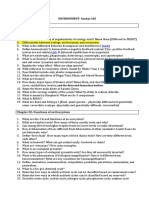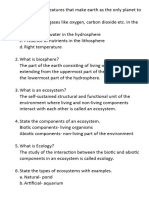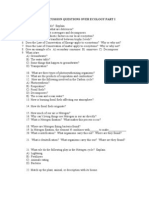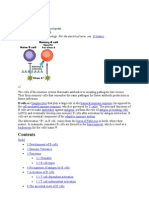2023 Ecosystem Review
2023 Ecosystem Review
Uploaded by
1061425Copyright:
Available Formats
2023 Ecosystem Review
2023 Ecosystem Review
Uploaded by
1061425Original Title
Copyright
Available Formats
Share this document
Did you find this document useful?
Is this content inappropriate?
Copyright:
Available Formats
2023 Ecosystem Review
2023 Ecosystem Review
Uploaded by
1061425Copyright:
Available Formats
Interaction Within the Ecosystem Test Review
1. What characteristics does an organism need to have to be considered living?
2. Which do not belong to the plant family?
a. Flowers and trees
b. Grasses and mosses
c. Trees and shrubs
d. Algae and fungi
3. What are the needs of all organisms?
a. Air, water, food, shelter, ability to interact
b. Air, water, shelter, ability to interact
c. Air, water, food, ability to interact
d. Air, water, food, shelter
4. What is an ecozone?
5. What is an ecosystem?
6. What is a community?
7. What is a biome?
8. Explain the difference between abiotic and biotic factors. Give three examples of
each in an ecosystem.
9. Water covers __________ percent of the earth’s surface.
10. A ______________ species are the first to live and colonize an ecosystem.
11. _______________ caused by wind, rain, ocean currents and sunlight will
eventually break down rock.
12. An ecological community will reach a stable state, where it no longer changes its
composition. This is known as a ______________________.
13. Which of these are examples of micro-organisms?
a. Fungi, bacteria, viruses, protozoans
b. Fungi, bacteria, protozoans
c. Fungi, viruses, protozoans
d. Bacteria, viruses, protozoans
14. Which are examples of primary consumers?
a. deer, wolves, grasshoppers, crows
b. deer, wolves, grasshoppers, cattle
c. deer, grasshoppers, rabbits, zebra
d. deer, grasshoppers, rabbits, rats
15. Which are examples of secondary consumsers?
a. humans, wolves, deer, lions
b. humans, wolves, lions, fox
c. humans, wolves, lions, cattle
d. wolves, lions, rabbit, zebra
16. List the three living elements in an ecosystem.
17. List the four non-living elements in an ecosystem.
18. What is the role of producers in the food chain?
a. to produce oxygen, to provide food for others
b. to produce oxygen and carbon dioxide
c. to produce oxygen and consume others
d. to provide food for others, to provide habitats
19. What is a community?
a. area where only plants live
b. area where plants and animals live
c. area where only animals live
d. area where plants and producers live
20. Consumers are organisms:
a. that uses sunlight to make food
b. that eats only plants
c. that feeds on others above them in the food chain
d. that feeds on others below them in the food chain
21. Describe the term organism.
22. Describe population.
23. List two beneficial uses for fungi.
24. Explain the importance of plants as camouflage.
25. Which of these animals are considered omnivores?
a. humans, grizzly bear
b. humans, deer
c. humans, wolves
d. deer, grizzly bear
26. Scavengers are organisms that:
a. a. break down the remains of dead plants
b. b. eat dead or decaying plants and animals
c. c. break down the remains of dead animals
d. d. eat plants and animals
27. Describe the term producer.
28. Describe the term consumer.
29. Describe the terms: herbivore, omnivore and carnivore.
30. Explain the brown food web. Why is this needed to sustain an ecosystem?
31. What is the difference between the brown and green food web?
32. Why are plants essential to ecosystems?
33. Explain the role of algae in water bodies and why it is important.
34. Define a decomposer. What are its roles?
35. List two beneficial uses for bacteria.
36. Explain how a food web operates. Use words like energy transfer, the sun,
producers, primary and secondary consumers, detritus etc.
37. Draw a food web (remember the arrows point from the sun to the organism, not
the other way around).
38. List a food chain in your food web.
39. Select 2 of the following parts of the food chain and explain their role: apex
consumers, secondary consumers, primary consumers, producers, decomposers,
scavengers and detritus
40. What is matter?
41. What is the water cycle? Explain the 4 key parts.
42. Describe three of the following matter cycles and why they are important:
nitrogen cycle, carbon cycle, water cycle, or phosphorus cycle.
43. What is nitrogen fixation and denitrification?
44. Explain eutrophication.
45. Why is it important to be able to cycle limited elements in an ecosystem?
46. Explain the difference between primary and secondary succession.
47. List 5 limiting factors of an ecosystem. Why are they important to know?
48. Explain how human impact has negatively impacted ecosystems. Suggest a
positive solution to this problem.
49. Explain 2 negative impacts and 2 positive impacts humans have had on the
environment.
50. What is sustainability in relation to ecosystems? What can we do to maintain
balance in ecosystems?
51. Explain the impact of climate change on ecosystems.
52. What is an invasive species? How does this change ecosystems?
53. Explain three reasons why organisms in an ecosystem may be endangered. Give
some solutions to help these species.
54. What is carrying capacity? Why is this important to all species?
55. Using your scientific knowledge, how can humans maintain sustainable
ecosystems and become carbon neutral by 2050? How will we be able to support our
growth beyond carrying capacity?
You might also like
- 1st Exam Envisci7 2022Document6 pages1st Exam Envisci7 2022Liezl ValienteNo ratings yet
- Ecology Study Guide 13-KeyDocument2 pagesEcology Study Guide 13-Keyapi-2608174140% (1)
- Review Exercise Questions Chapter 3Document7 pagesReview Exercise Questions Chapter 3APES2000No ratings yet
- Evs PDFDocument40 pagesEvs PDFmahimaNo ratings yet
- Control of Gene Expression in Prokaryotes: Diagram ADocument4 pagesControl of Gene Expression in Prokaryotes: Diagram ARoberto CastroNo ratings yet
- Environmental Science and EngineeringDocument19 pagesEnvironmental Science and EngineeringsasisNo ratings yet
- SCIENCEDocument4 pagesSCIENCEangelotorio27No ratings yet
- Environmental Science Prelim ExamDocument3 pagesEnvironmental Science Prelim ExamNanetteNo ratings yet
- Lakhmir Singh Solutions Class 10 Biology Chapter 5 Our EnvironmentDocument22 pagesLakhmir Singh Solutions Class 10 Biology Chapter 5 Our EnvironmentMadheti DARSHATNo ratings yet
- 1ST Periodical TestDocument4 pages1ST Periodical TestSheryl R. Valiente100% (1)
- Ecologyreviewsheet2 Answer KeyDocument6 pagesEcologyreviewsheet2 Answer Keyapi-235160519No ratings yet
- Te-Our Environment Final Revisor (2022-23)Document86 pagesTe-Our Environment Final Revisor (2022-23)Gautam SharrmaNo ratings yet
- Class 10 Science Important Questions: Our EnvironmentDocument6 pagesClass 10 Science Important Questions: Our EnvironmentGaurav YadavNo ratings yet
- Shankar Ias Revision QuestionsDocument45 pagesShankar Ias Revision Questionskingu kingNo ratings yet
- Marulas Christian School Third Periodical Exam Science-6Document4 pagesMarulas Christian School Third Periodical Exam Science-6iyaNo ratings yet
- Second Periodical Test in Science 6Document8 pagesSecond Periodical Test in Science 6Abegail H. Laquiao83% (36)
- Our EnvironmentDocument3 pagesOur Environmentkm meenakshiNo ratings yet
- ECOSYSTEMSDocument8 pagesECOSYSTEMSammarahn0No ratings yet
- X - Bio - CH 13 - Our Envt - Question BankDocument21 pagesX - Bio - CH 13 - Our Envt - Question Bankt.v.tejeshwar123No ratings yet
- Ecology PracticeTest 1Document3 pagesEcology PracticeTest 1h8alfredNo ratings yet
- Biology PracticeDocument8 pagesBiology Practicemk.edward0609No ratings yet
- Med EasyDocument6 pagesMed Easyjanvipuri2008No ratings yet
- CH 3.1-4.3 Practices - StudentDocument6 pagesCH 3.1-4.3 Practices - Studentq124415669No ratings yet
- ExamplesDocument5 pagesExamplesanosuyaroy28No ratings yet
- 50 Items Multiple ChoiceDocument8 pages50 Items Multiple ChoiceJueren MaciaNo ratings yet
- STUDY QUESTIONS Anthony-1Document9 pagesSTUDY QUESTIONS Anthony-1Samson BaloNo ratings yet
- TTS Multiple ChoiceDocument8 pagesTTS Multiple ChoiceJueren MaciaNo ratings yet
- Ecology Test: Study Guide AnswersDocument12 pagesEcology Test: Study Guide Answersapi-267855902No ratings yet
- Ecosystem 2Document2 pagesEcosystem 2Uniyals AcademyNo ratings yet
- Biology: Ecology Study Guide.Document2 pagesBiology: Ecology Study Guide.Ahmad FarooqNo ratings yet
- Science6 Q2 Mod6 EcosystemTropicalRainforestsCoralsReefsandMangroveSwamps V4Document26 pagesScience6 Q2 Mod6 EcosystemTropicalRainforestsCoralsReefsandMangroveSwamps V4Meya E. MarohombsarNo ratings yet
- What Is EcosystemDocument6 pagesWhat Is EcosystemSatnam English Classes ਅੰਗਰੇਜ਼ੀ ਸਿੱਖੋNo ratings yet
- Science7 Q2 Module5 (Week6-7)Document36 pagesScience7 Q2 Module5 (Week6-7)nona wayne dela peñaNo ratings yet
- Our EnvironmentDocument12 pagesOur Environmentanitaagarwal19891984No ratings yet
- Chapter Our EnvironmentDocument3 pagesChapter Our Environmentarpita7953No ratings yet
- GE 2021 - Environmental Science and Engineering - (Unit-I)Document6 pagesGE 2021 - Environmental Science and Engineering - (Unit-I)winvenuNo ratings yet
- EVS 2 Marks and 16 Marks PDFDocument89 pagesEVS 2 Marks and 16 Marks PDFAnonymous sE6DFONo ratings yet
- Our Environment: Solution: SolutionDocument18 pagesOur Environment: Solution: SolutionGoogle boy aman beniwalNo ratings yet
- Ge3451 - QBDocument200 pagesGe3451 - QBganeshpavi118No ratings yet
- GE 6351 2 Mark & Ans) - Rejinpaul PDFDocument12 pagesGE 6351 2 Mark & Ans) - Rejinpaul PDFAnonymous NoLC1bXCNo ratings yet
- AP Bio Discussion Questions Over Ecology Part IDocument3 pagesAP Bio Discussion Questions Over Ecology Part IElizabeth WarsopNo ratings yet
- LONG QUIZ G9 For HealthDocument9 pagesLONG QUIZ G9 For Healthqjsmedina01No ratings yet
- Ecology Revision - Previous TopicsDocument30 pagesEcology Revision - Previous Topicsxofah81094No ratings yet
- Ecology QuestionsDocument4 pagesEcology QuestionsMrGilmartinNo ratings yet
- CH 5Document22 pagesCH 5Utkarsh GuptaNo ratings yet
- Shankar Ias Revision QuestionsDocument24 pagesShankar Ias Revision QuestionsSNo ratings yet
- Geography Chapter 1Document4 pagesGeography Chapter 1t6003228984No ratings yet
- Level 8 General Science NotesDocument26 pagesLevel 8 General Science NotesMadiha JabbarNo ratings yet
- Ecosystem MCQ 2-3Document10 pagesEcosystem MCQ 2-3Jyothi WNo ratings yet
- 4.1 Species, Communities and Ecosystems PracticeDocument4 pages4.1 Species, Communities and Ecosystems PracticeJames ArpinNo ratings yet
- Revision Sheet - Docx-2Document6 pagesRevision Sheet - Docx-2mofid monirNo ratings yet
- Bank Soal IPAS Semester 1Document19 pagesBank Soal IPAS Semester 1ayuhasriani28No ratings yet
- Grade 6 CT2Document6 pagesGrade 6 CT2shamshadNo ratings yet
- Q2 Module 14 Lesson 9 10Document8 pagesQ2 Module 14 Lesson 9 10RavenNo ratings yet
- Third Semester Environmental Science Two Marks With Answers Regulation 2013Document89 pagesThird Semester Environmental Science Two Marks With Answers Regulation 2013PRIYA RAJINo ratings yet
- Environmental Science QuizDocument17 pagesEnvironmental Science Quizchristiangalvan601No ratings yet
- Ecosystem Activity SheetDocument2 pagesEcosystem Activity Sheetineveen4No ratings yet
- q.BANK ENDocument16 pagesq.BANK ENjahac80355No ratings yet
- Gr.5 3rd Term Science Revision Sheet M.ADocument12 pagesGr.5 3rd Term Science Revision Sheet M.Amohamedelrayah2010No ratings yet
- O Level Biology Practice Questions And Answers: Ecology And Our Impact On The EcosystemFrom EverandO Level Biology Practice Questions And Answers: Ecology And Our Impact On The EcosystemNo ratings yet
- 2nd Open Book Exam, Aseel AlharbiDocument6 pages2nd Open Book Exam, Aseel Alharbiعبدالرحمن الحربي100% (1)
- Sequences Alignments (Similarity & Homology)Document32 pagesSequences Alignments (Similarity & Homology)monkey_isaacNo ratings yet
- How Representative Animals ReproduceDocument29 pagesHow Representative Animals ReproduceIMY PAMEROYANNo ratings yet
- How The Genes Are Regulated & Expressed?: AssignmentDocument17 pagesHow The Genes Are Regulated & Expressed?: AssignmentSuraiya Siraj NehaNo ratings yet
- The Immune System and Lymphoid OrgansDocument68 pagesThe Immune System and Lymphoid OrgansAbraham Dawson machachaNo ratings yet
- Cell Division LabDocument8 pagesCell Division Labtworedpartyhats67% (6)
- B CellDocument13 pagesB CellSrini VasanNo ratings yet
- SS1 BiologyDocument4 pagesSS1 Biologyolufemi aladejebiNo ratings yet
- Cell Cycle and Mitosis WorksheetDocument3 pagesCell Cycle and Mitosis Worksheetjulia.dukeNo ratings yet
- Anterior-Posterior Patterning in The Drosophila EmbryoDocument50 pagesAnterior-Posterior Patterning in The Drosophila Embryolifes.fallenangelNo ratings yet
- Chapter 13: Meiosis and Sexual Life Cycles: Name - PeriodDocument9 pagesChapter 13: Meiosis and Sexual Life Cycles: Name - PeriodmynameNo ratings yet
- Ecology and EcosystemDocument13 pagesEcology and EcosystemKush TejaniNo ratings yet
- MM Protein Synthesis Activity CBdiTEEDocument6 pagesMM Protein Synthesis Activity CBdiTEESHARIFAH BINTI HASSAN MoeNo ratings yet
- Introduction To Avian Immunity - Part 3Document20 pagesIntroduction To Avian Immunity - Part 3nurulNo ratings yet
- Bioinformatics Prof. M. Michael Gromiha Department of Biotechnology Indian Institute of Technology, Madras Lecture - 7b Sequence Alignment IIDocument26 pagesBioinformatics Prof. M. Michael Gromiha Department of Biotechnology Indian Institute of Technology, Madras Lecture - 7b Sequence Alignment IIPrativa DebNo ratings yet
- Bio 103 L4 NIADocument17 pagesBio 103 L4 NIAsubrotoghosh2001No ratings yet
- Purnomo Suryohudoyo: Dept. of Biochemistry School of Medicine Airlangga UniversityDocument32 pagesPurnomo Suryohudoyo: Dept. of Biochemistry School of Medicine Airlangga UniversityAlif FakhrurroziNo ratings yet
- 18 Cell Cycle Regulation-SDocument6 pages18 Cell Cycle Regulation-SkriishnaNo ratings yet
- Ecosystem Class 12 BiologyDocument11 pagesEcosystem Class 12 BiologykusumabshuklaNo ratings yet
- Society For Ecological Restoration - 2004Document15 pagesSociety For Ecological Restoration - 2004Joni AcayNo ratings yet
- Reproduction in Algae 4Document26 pagesReproduction in Algae 4James manganya mbeweNo ratings yet
- Senescencia Celular - Una Perspectiva Traslacional - Traducción AutomáticaDocument7 pagesSenescencia Celular - Una Perspectiva Traslacional - Traducción AutomáticaEduardo MartelNo ratings yet
- 60 Assertion Reason MCQs by DR NK Sharma Molecular Basis of InheritanceDocument8 pages60 Assertion Reason MCQs by DR NK Sharma Molecular Basis of InheritanceDiNo ratings yet
- 7.93 - Lecture #4 - and - Multiple Sequence Alignment: More Pairwise Sequence ComparisonsDocument44 pages7.93 - Lecture #4 - and - Multiple Sequence Alignment: More Pairwise Sequence ComparisonsHaMmAd KhAnNo ratings yet
- Cell DevisionDocument8 pagesCell DevisionpuspaNo ratings yet
- Module 1Document38 pagesModule 1Rochelle BambaNo ratings yet
- Mitosis QuizDocument2 pagesMitosis Quizkarim karakiraNo ratings yet
- Transcription in ProkaryotesDocument15 pagesTranscription in ProkaryotesFenet AdamuNo ratings yet
- Cell Growth and DivisionDocument37 pagesCell Growth and DivisionLinda Yurani Carvajal AngaritaNo ratings yet

























































































